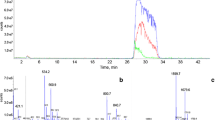Abstract
Capillary zone electrophoresis (CZE) was used to investigate interactions between heparin and programmed cell death 5 (PDCD5), and between heparin and PDCD5-related peptides. Samples containing PDCD5, PDCD5-related peptides, and heparin at various ratios were incubated at room temperature and then separated by CZE with tris-acetate buffer at pH 7.2. Both qualitative and quantitative characterizations of the binding of PDCD5 and PDCD5-related peptides to heparin were determined. The changes in the signals of PDCD5 and PDCD5-related peptides were monitored by comparing the electropherograms of the mixtures containing PDCD5 and heparin and PDCD5-related peptides and heparin with that of PDCD5 or PDCD5-related peptides only. The binding constant of the interaction between PDCD5 and heparin was calculated as 4.17 × 104 M−1 by Scatchard analysis. Our investigations show that it is possible to characterize the interaction between PDCD5 and heparin quantitatively and the interaction between PDCD5-related peptides and heparin qualitatively using CZE.









Similar content being viewed by others
References
Liu HT, Wang Y, Zhang YM, Song QS, Di CH, Chen G, Tang J, Ma DL (1999) Biochem Biophys Res Commun 254:203–210
Wang Y, Li X, Wang L, Ding P, Zhang YM, Han WL, Ma DL (2004) J Cell Sci 117:1525–1532
Zhang YM, Xu XZ, Liu HT, Song QS, Ma DL (2000) J Chin Immun 16:8–11
Wang Y, Li D, Fan H, Tian L, Zhong YC, Yuan L, Zhang YM, Jin CN, Yin CH, Ma DL (2006) J Biol Chem 281:24803–24817
Tyagi M, Rusnati M, Presta M, Giacca M (2001) J Biol Chem 276:3254–3261
Colin S, Jeanny J, Mascarelli F, Vienet R, Mahmood SA, Courtois Y (1999) J Labarre Mol Pharmacol 55:74–82
Li XT, Mo XN, Xia DL, Liu YN, Song QS, Zhang YM, Ma DL (2002) Chinese J Biochem Mol Biol 18:411–417
Ruoslahti E (1989) J Biol Chem 264:13369–13372
Esko JD (1991)Curr Opin Cell Biol 3:805–816
Wender PA, Mitchell DJ, Pattabiraman K, Pelkey ET, Steinman L, Rothbard JB (2000) Proc Natl Acad Sci USA 97:13003–13008
Liu D, Feng Y, Cheng Y, Wang J (2004) Biochem Biophys Res Commun 318:391–396
Kwak YT, Guo J, Shen J, Gaynor RB (2000) J Biol Chem 275:14752–14759
Delhase M, Hayakawa M, Chen Y, Karin M (1999) Science 284:309–313
Yamaoka S, Courtois G, Bessia C, Whiteside ST, Weil R, Agou F, Kirk HE, Kay RJ, Israel A (1998) Cell 93:1231–1240
Rothwarf DM, Zandi E, Natoli G, Karin M (1998) Nature 395:297–300
Mercurio F, Murray BW, Shevchenko A, Bennett BL, Young DB, Li JW, Pascual G, Motiwala A, Zhu H, Mann M, Manning AM (1999) Mol Cell Biol 19:1526–1538
May MJ, D’Acquisto F, Madge LA, Glöckner J, Pober JS, Ghosh S (2000) Science 289:1550–1554
Rehman KK, Bertera S, Bottino R, Balamurugan AN, Mai JC, Mi Z, Trucco M, Robbins PD (2003) J Biol Chem 278:9862–9868
Zhou W, Kenneth BT, Morteza GK (2000) Anal Biochem 284:334–341
He XY, Ding YS, Li DZ, Lin BC (2004) Electrophoresis 25:697–711
Militsopoulou M, Lamari F, Karamanos NK (2003) J Pharm Biomed Anal 32: 823–828
Bohlin ME, Kogutowska E, Blomberg LG, Heegaard NHH (2004) J Chromatogr A 1059:215–222
Le Saux T, Varenne A, Perreau F, Siret L, Duteil S, Duhau L, Gareil P (2006) J Chromatogr A (online)
He XY, Ding YS, Li DZ, Lin BC (2004) Electrophoresis 25:697–711
Liu Y, Ling XM, Cui JR (2006) Chinese J Pharm Anal 26:1350–1357
Liang A, He YX, Du YG, Wang KY, Fung YS, Lin BC (2004) Electrophoresis 25:870–875
Liu Y, Lai XY, Ling XM, Zhao YY, Cui JR (2006) Chromatographia 64:45–50
Acknowledgements
This work was financially supported by the National High-Tech Research and Development Program of China (863 Program) (2004AA2Z3783 and 2002BA711A01) and a grant from the State Key Program of Basic Research (G2000056909).
Author information
Authors and Affiliations
Corresponding authors
Rights and permissions
About this article
Cite this article
Ling, X., Liu, Y., Fan, H. et al. Studies on interactions of programmed cell death 5 (PDCD5) and its related peptides with heparin by capillary zone electrophoresis. Anal Bioanal Chem 387, 909–916 (2007). https://doi.org/10.1007/s00216-006-0983-3
Received:
Revised:
Accepted:
Published:
Issue Date:
DOI: https://doi.org/10.1007/s00216-006-0983-3




